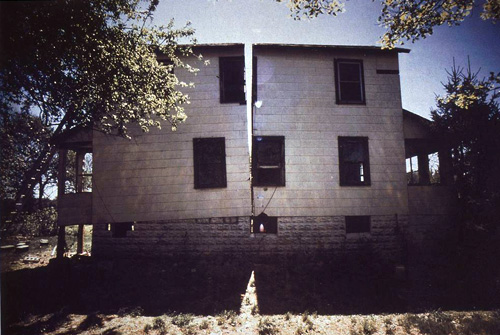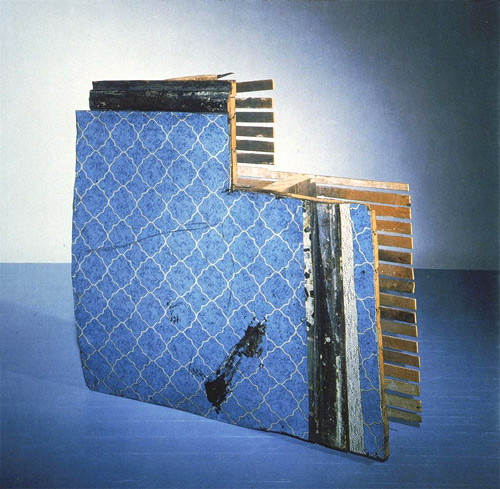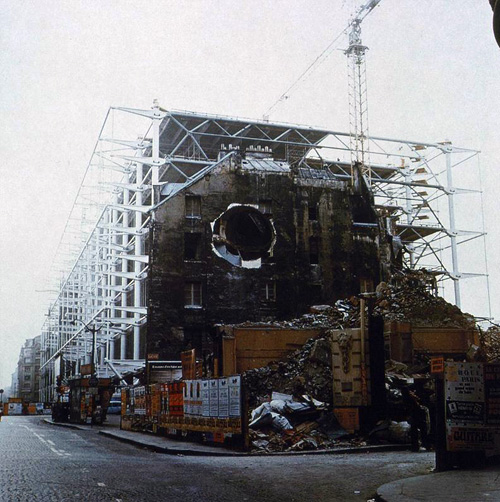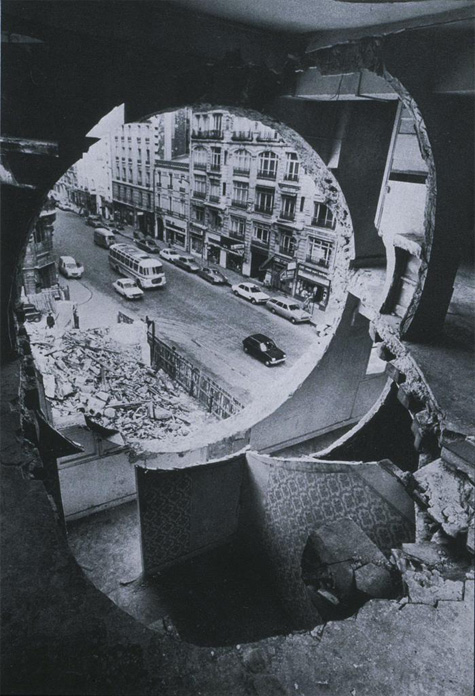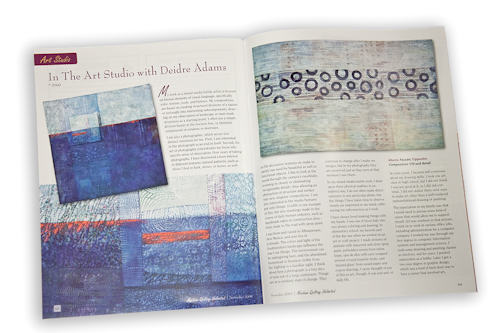Gordon Matta-Clark — Artist, Activist, Anarchitect
Gordon Matta-Clark, Splitting, 1974
Completion through removal. Abstractions of surfaces. Not-building, not-to-rebuild, not-built-space. Creating spatial complexity, reading new openings against old surfaces. Light admitted into space or beyond surfaces that are cut. Breaking and entering. Approaching structural collapse, separating the parts at the point of collapse.
— Gordon Matta-Clark, 1971
I’ve just spent a couple of weeks researching the work of Gordon Matta-Clark for a paper for my Art Theory & Criticism class this semester. The assignment was to choose an artist and/or specific work to tie in with some of the theories we had been discussing in our readings. Deconstruction theory* is very interesting to me, so I started with a Google search on that term and came up with Gordon Matta-Clark. As soon as I saw the images that came up, I remembered having seen a slide of his work in an earlier art history class. The slide we saw was from his work Bingo, in which he cut out sections from the side of an old condemned house. Some of these sections were saved, and this slide shows them placed in a pristine museum setting — a striking contrast of particular interest for me because I find abandoned structures so compelling.
Gordon Matta-Clark was quite an interesting guy. He was the son of two artists — Chilean surrealist painter Roberto Matta and American artist Anne Clark. Marcel Duchamp was his godfather. He was active during the early 70s and died an untimely death from cancer when he was only 35. His work is somewhat difficult to categorize, consisting of elements of sculpture, drawing, film, performance, social activism, and “semantic deconstruction,” a label applied to his fondness for word play in his documentation.
His most well-known works are probably those often referred to as the “building cuts.” The earliest works involving cutting of buildings were “urban guerilla acts” in which he illegally entered abandoned apartment buildings and cut out parts of what would have been a floor on one level and a ceiling for the level below. These cut-out fragments were displayed in a gallery setting as Bronx Floors.
Gordon Matta-Clark, Bronx Floors, 1972-73
As he gained notoriety, Matta-Clark was able to gain legal access to various condemned structures in order to perform his interventions. Splitting (top) is probably his most iconic work, consisting of a house which he cut completely in half. He and his collaborators were able to remove part of the foundation on one side so that the affected half tilted back and transformed the opening into a dramatic wedge, widening from bottom to top.
Matta-Clark was interested in the social aspects of how abandonment and urban renewal would affect and displace communities. His ideas about consumerism and capitalism seemed to be taken almost directly from the Situationists: the concepts of psychogeography, dérive, and détournement. In explaining his “dualistic habit of centering and removal,” he said,
Here I am directing my attention to the central void, to the gap which, among other things, could be between the self and the American Capitalist system. What I am talking about is a very real, carefully sustained mass schizophrenia in which our individual perceptions are constantly being subverted by industrially controlled media, markets, and corporate interests. … This conspiracy goes on every day, everywhere, while the citizen commutes to and from his shoe-box home with its air of peace and calm, while he is being precisely maintained in a state of mass insanity.
[i]Matta-Clark was trained as an architect, having received a B.A. in architecture from Cornell University in 1968. But he spent a lot of time in the company of artists while in college, and he expressed some disaffection with the field of architecture, and especially with the type of modernist ideas he encountered there. After leaving Cornell, Matta-Clark moved to New York City, to an area now known as SoHo but which was then called the South Houston Industrial area. At that time, the area was in a state of decline, a prime example of urban decay, with numerous abandoned buildings and streets lacking lighting and maintenance. Since the 1950s, artists had been attracted to the area for the cheap rents, living illegally in buildings zoned for commercial, not residential use. In the late 1960s, the city’s urban planners and wealthy landowners wanted to transform the area into a modern corporate and financial center, an idea which was met with no small resistance by the inhabitants.
At this time, much of Matta-Clark’s work involved a spirit of community, calling attention to the plight of the poor and homeless and involving neighbors and other artists in the work’s creation. He had several ideas for making building materials from discarded bottles and other trash, with thoughts of developing some of these ideas into places for the homeless to live.[ii] He explained his motivation:
As a native New Yorker my sense of the city as home runs deep … [and] my attitudes are still keener as regards an awareness of prevailing conditions and their need for improvement. Among the conditions my training and personal inclination have taught me to deal with is neglect and abandonment. There are words which when applied to children or human beings of any age evoke a profound call for alarm and rectification, yet when existing in massive proportions throughout our urban environment evokes only bureaucratic or juridic ambivalence and in-action.[iii]
Matta-Clark’s ideas about the social content of his work grew clearer to him as he progressed in his career. In a 1976 interview with Donald Wall, after he had done several building-cut projects, he reiterated his commitment to fighting against what he saw as a flawed system:
By undoing a building there are many aspects of the social conditions against which I am gesturing: first, to open a state of enclosure which had been preconditioned not only by physical necessity but by the industry that profligates suburban and urban boxes as a context for insuring a passive, isolated consumer—a virtually captive audience.[iv]
In 1975, Matta-Clark began work on Conical Intersect, one of his more complex building interventions. In Paris at this time, the old section of the city known as Les Halles was being demolished to make way for modernization, including the building of the then-controversial Centre Georges Pompidou. Matta-Clark obtained permission to work on two 17th-century houses that were the last to be demolished to make way for the modernization project.
Gordon Matta-Clark, Conical Intersect, 1975
Having been to the Pompidou myself last summer, I found this especially interesting. The pictures are fascinating, but how amazingly cool it would have been to be able to experience this first-hand. These works could only exist, and for only a short time, because they would subsequently be destroyed. All that remains are photographs and film of the process.
Interior view of Conical Intersect
I can’t help feeling nostalgic when older buildings are demolished to make way for the new. I know that’s a kind of sentimental attitude, and we must have progress and all that, but I just like the character of old buildings better than new ones. If I never saw what was there before, of course I couldn’t give that too much thought, but Gordon Matta-Clark did want people to think about that, and that’s why I love his work so much.
_______________
*Deconstruction is a literary theory credited to Jacques Derrida, who is maddeningly difficult to read. I found a very understandable explanation of deconstruction in Literary Theory for the Perplexed by Mary Klages. (Wow – Amazon seriously wants $132 for this book? Good thing we have libraries!)
______________________________________________________________________________________________________________
[i]Gordon Matta-Clark, Interview by Donald Wall, 1976, in “Gordon Matta-Clark’s Building Dissections,” in Gordon Matta-Clark: Works and Collected Writings, ed. Gloria Moure (Barcelona: Ediciones Poligrafa, 2006), 58.
[ii]Christian, Scheidemann, “Material and Process: Gordon Matta-Clark’s Object Legacy, in Gordon Matta Clark: You are the Measure. Exhibition catalog published by the Whitney Museum of American Art (New Haven: Yale University Press, 2007), 119.
[iii]Gordon Matta-Clark, notes from the Estate of Gordon Matta-Clark, quoted in Judith Russi-Kirchner, “The Idea of Community in the Work of Gordon Matta-Clark,” in Gordon Matta-Clark, ed. Corinne Diserens (London: Phaidon Press Limited, 2003), 148.
[iv]Matta-Clark, Wall interview, 57.

